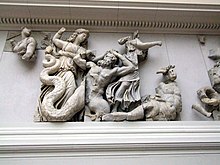Gigantomachy
The Gigantomachy or Gigantic Battle describes the battle of the Greek gods with the giants , with the god father Zeus being their leader. He is often confused with the Titanomachy , but these fight with the titans, who, unlike the giants, are immortal.
The struggle of the giants against the gods was supposed to symbolically show the rebellion of chaotic, unruly and unlawful disorder against law, order and law and has been a popular motif for modern art since ancient times.
The course of the fight is described in detail by Apollodorus ( Peri Theon ). Even Homer ( Odyssey ), Hyginus ( Poetica Astronomica ), Pausanias and Nonnos wrote about him.
overview
Encouraged by their mother Gaia , who was offended because Zeus had locked their sons, the Titans , in the underworld, the giants, led by Eurymedon , threw huge boulders and burning oaks against the sky.
According to Karl Kerényi , Gaia always supported those who turned against heaven, and because the new gods, the Olympians, now ruled as sons of heaven, also the fight against them.
Gaia was looking for a plant that would immortalize her children. But Zeus forbade Eos , Helios and Selene (the deities of dawn, sun and moon) to shine and even found the plant in the dark. As a result, the gods seemed to have an advantage over the giants, but an oracle prophesied that they would only be victorious with the help of a mortal. a. because giants cannot die by the hand of gods.
Athena therefore recruited Heracles for support, and the Olympians came to help through him and Dionysus , both sons of Zeus whom he had fathered with mortal women, Heracles in particular making a decisive contribution to the victory against the giants. He killed many of the giants struck down by the Olympian gods and goddesses and the goddesses and gods like Nyx and Hecate who fought with them with his arrows, the tips of which were soaked with the poisonous blood of the hydra he slain .
Exact sequence
Alkyoneus , one of the strongest giants, was hit by an arrow from Heracles, which was used as a helper by Zeus, the father of gods, and died. The second most powerful giant, Porphyrion , attacked Hera and Heracles to steal the goddess, but Zeus hit him with a lightning bolt and Heracles killed him with an arrow. Apollo and Heracles met Ephialtes each in the eye, causing him to die. Dionysus killed Eurytus with his Thyrsus , Hecate burned Clytius with her torches, Hephaestus fatally hit Mimas with red-hot iron. Enkelados fled, but Athena threw Sicily over him, then she killed Pallas (and from then on used his skin as a shield). Poseidon threw Nisyros , part of the Dodecanese group of islands and the neighboring island of Kos , at Polybotes . Hermes - invisible through the cap of Hades - killed Hippolytus . Artemis shot Gration . The Moiren killed Agrios and Thoas with their bronze clubs. The rest of the giants were killed by Zeus 'lightning and Heracles' arrows.
So, with the help of a mortal, the gods defeated the giants. Gaia was furious and gave birth to the terrifying Typhoeus .
presentation
The most famous representation of the Gigantomachy is the outer frieze of the Pergamon Altar in Berlin. Another work is in the Palazzo del Te in Mantua. The room, designed by the painter Giulio Romano and his assistants around 1534 as Sala dei Giganti (room no. 11, corner room) impresses with its frescoes painted on the wall and ceiling and its sometimes larger than life figures of giants (see picture).
Metaphorical use
The place in the Platonic dialogue of Sophistes is famous , where Plato lets the Eleatic strangers describe the dispute between the followers and opponents of the theory of ideas (Platonists against Epicurean atomists) as a "giant battle for being" (γιγαντομαχία περὶ τῆς οὐσίαςes 246). Martin Heidegger uses the term in Being and Time to clarify the necessity of repeating the question of being in philosophy.
Likewise, the term giant battle after the Persian wars symbolized the Greek-Persian conflicts, with the Greeks assuming the role of the Olympian gods and the Persians the role of the giants.
literature
- Johannes Ilberg , Ernst Kuhnert : Giants . In: Wilhelm Heinrich Roscher (Hrsg.): Detailed lexicon of Greek and Roman mythology . Volume 1, 2, Leipzig 1890, Sp. 1639–1673 ( digitized version ).
- Francis Vian : Repertoire des gigantomachies figurées dans l'art grec et romain. C. Klincksieck, Paris 1951.
- Francis Vian: La Guerre des Géants. Le Mythe avant l'époque hellénistique . C. Klincksieck, Paris 1952.
Web links
- The gigantomachy represented by Apollodorus, Greek and German text with an introductory table of contents
- Thomas Gransow: The Pergamon Altar , in which not only the artistic implementation of the gigantomachy theme, but also the sequence of the mythological event are well represented.
- Depiction of the Pergamon Altar


